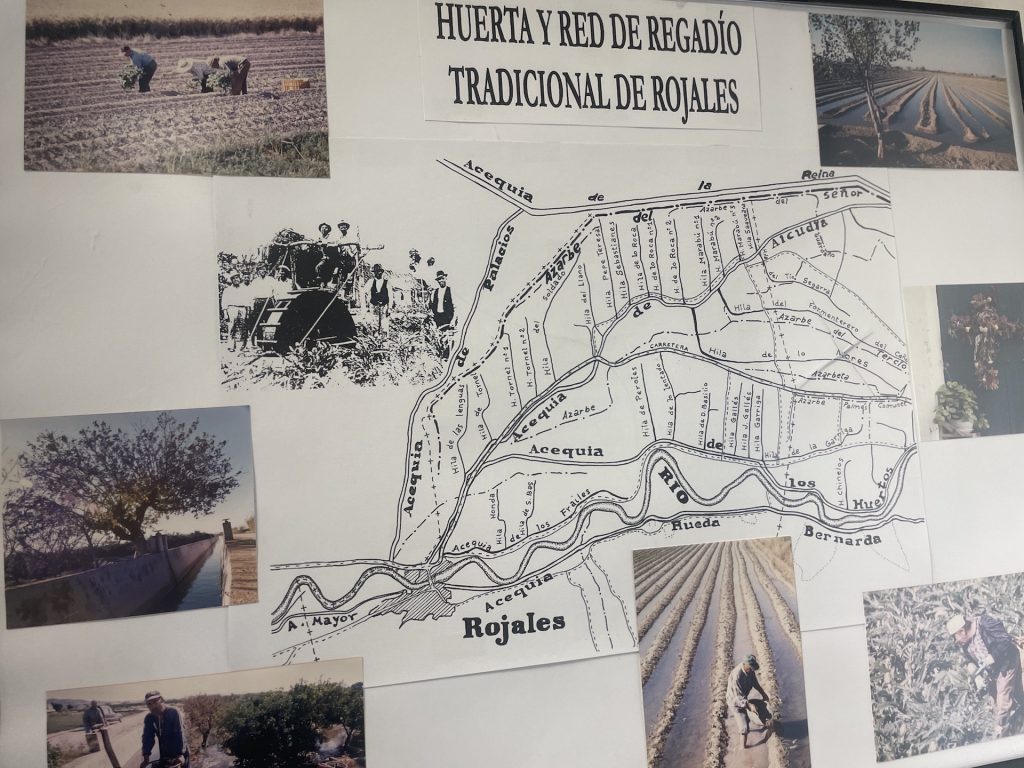I have been travelling quite a lot or rather I have lived in other countries, for months or years at a time. One thing that I quickly came to realize is that the locals really appreciate when you show interest for their culture, language, and history.
Heritage sites Southern Alicante small scale farming
La Vega Baja. It is a region where the history and culture is so connected to small scale farming, the river Segura, wetlands and lagoons. A part from Orihuela, which used to be the political and religious centre of la Vega Baja there are not that many monument and grand buildings. Elche is a city with interesting historical remains. Nevertheless the most prominent features are the old palm groves , great food and plantations with a long history.
As for myself, I would usually go for the perhaps sometimes more “learning” experiences and how the old is connected to the new. How challenges from past times can show us solutions for the future.
Water systems and small scale farming culture
For some time now I have been interest in the culture around water in La Vega Baja. It is a region where water has always been scarce. Today the reality seems to be draught combined with potential heavy rain falls with often devastating effects.
Since far far back , the hydraulic system of the region depends on the Rio Segura. It is a river that flows through many of the localities and provides water to the fields.
In the “Museo de la Huerta” in Rojales you can see maps of the complex irrigation systems. In the below photo you can see the ditches ( acequias), channel where the excess water from irrigation ends up ( azarbes) and water wheels.

The River Segura pass through the provinces of Jaén, Albacete, Murcia and Alicante. It goes from Orihuela all the way down to the Mediterranean Sea.

Water systems names from the Arab times
The different components of the irrigation system have Arabic names. For example the Los Aljibes . These are water cisterns that started to appear during Arab time and quickly became part of the water system. It is a way to collect and store rain water.
Nevertheless you can find cisterns that go even further back. An ancient Roman cistern has been discovered in Santa Pola
The town hall of Santa Pola planned to save a late 18th-early 19th century ‘aljibe’ cistern when the archaeologists noticed remains that was typically used in Roman hydraulic constructions.
In the town of Rojales you can find several Urban hydraulic monuments such as the Azud ( A thick wall, ,built into a river to divert water into a channel or ditch) the, Boqueras de Acequia( nozzle for irrigation ditches), Noria ( water wheels) and the old Bridge from the 16th-18th century.
Great hiking along the River Segura
I have decided to walk along the River Segura every time I go to Villa Balea. Each time a new stretch. On my last stay in January I invited some Spanish friends to walk with me and my relative Lena. My Spanish friends were pleasantly surprised. It is truly nice to walk along the river side. There is a great tack for hiking and cycling. We met up with a lot of people hiking, cycling as well as a big herd of goats that roamed the river side.
Future challenges and how to create “floodable” green areas
For Spanish localities in the Vega Baja area the closeness to a river is a blessing but it can also create problems. There have been several Dana with devastating effects, one in 2019 and one in 2024 . The DANA is a destructive weather system in which cold and warm air meet and produce powerful rain clouds, a pattern believed to be growing more frequent due to climate change.
Since 2019, several initiatives have been taken to improve conditions around the river Segura such carry out works in the riverbed. Despite building floodable parks and water recovery ponds, the initiatives remain “insufficient” says many experts
Biodiversity in the El Recorral Rojales park
This floodable park is a sustainable alternative to solve water management in municipality. In the event of floods, they store the water that falls torrentially. In addition, they can be the perfect container for storing wastewater, where it can then be treated to be regenerated and reused to irrigate parks and gardens. Much of the wastewater discharges previously ended up in the La Mata lagoon nature reserv.
In addition the landscape and park design of this green infrastructure makes it into a park where you can walk and enjoy native species originating from the region. You can find native plants such as willows, maples, ashes, elms and white poplars. There are also drought-resistant species such as pines, rosemary, thyme, lavender, esparto grass and much.

